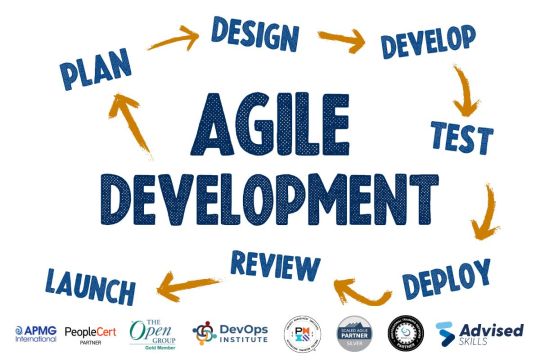#Agile development
Explore tagged Tumblr posts
Text
Oh. I think I know what this is: Rugby. They're playing rugby. …is this called a scrum, maybe?
47 notes
·
View notes
Text
I guess my complaint about agile is that I just got off a $26,000 phone call where I did nothing and we have another one every two weeks forever
#agile development#programming#scrum#hourly wage times people times hours#this meeting could have been an email
42 notes
·
View notes
Text
Disruptive Business Strategies: Innovate, Compete, and Succeed
Disruptive business strategies are innovative approaches that challenge the status quo of the industry and introduce new products, services, or business models that change the way things are done. Here are a few examples of disruptive business strategies that have expanded businesses worldwide: Uber: Uber is a ride-sharing service that disrupted the traditional taxi industry. Instead of owning a…

View On WordPress
#agile development#business competition#business leadership#business strategy#business success#business tips#competitive advantage#competitive edge#creative culture#emerging trends#grow business#industry norms#innovation#market disruption#market opportunity#marketing#technology#user experience
2 notes
·
View notes
Text
When it comes to bringing your startup's vision to life, product development can often make or break your success. But don't worry; you're not alone in this journey! Discover the secret sauce of successful product development. This comprehensive infographic navigates you through the critical stages of building a winning product using insights and methodologies honed by Mobio Solutions. Whether you're just starting or scaling your startup, this infographic has something for everyone.
Don't miss the chance to put your startup on the fast track to success!
#startups#product development#software development company#agile development#agile for startups#agileproductdevelopment#businessefficiency#technology#innovation#mobio solutions
3 notes
·
View notes
Text
Corporate developers often use Agile methodology, so don't beat yourself up for not having a planning system as an amateur! It might be helpful to consider adopting one though if you're a fountain of ideas or find it difficult to prioritise moment to moment.
So as a really high level summary of Agile development, the development team decides what gets focus each week or so. Cycle time varies widely from organization to organization based on what works best for the team, but usually the goal is to keep them at around a week or so. The development team maps out some measurable tasks (there's a clear beginning and end so it's "deliverable"), and commits to that handful of tasks for that defined time period, taking into account how much time each task is expected to last and then padding that estimate to account for unknowns and not overload themselves. Other aspirations/tasks pop up? No problem! They're logged, then placed in a backlog list (unless they're urgent and literally cannot wait) then they get reviewed in the next planning session to see how they fit into the priorities of the next cycle.
Kanban boards are a common accompaniment to Agile development. You can build personal ones for free on sites like Trello or ClickUp (they both have mobile apps too in case you have thoughts while away from your computer). You can even keep multiple boards for different purposes or types of tasks. Many people use kanban boards for non-development projects. Writing, crafts, filing your taxes, whatever- it's very flexible.
There are a lot of courses on how to use kanban boards but basically it's for tracking statuses of assigned tasks. Common columns are "Open" (tasks selected for a cycle), "Blocked" (tasks that can't continue until an issue is resolved), "In Progress", and "Done" but it's highly customizable.
It doesn't have to feel authoritarian and corporate. Many successful dev teams prefer Agile for the sense of structure and the ability to track what they learn about the ups and downs of each project. It's not a tool to judge personal performance and some Agile systems (like Scrum) even have strict rules against assigning blame. It's ultimately about patience, both for yourself and your projects.
In the end, these are your projects and you're doing them for yourself. You call the shots and there is absolutely no problem with setting tasks aside when you find something too hard for now, you fall out of love with a project, or just need time away for whatever reason. If it sucks hit the bricks (log what happened, throw it back into the backlog or close it completely, pick something more fulfilling). It happens all the time in the professional world, and you should allow yourself the same amount of grace if not even more when you're acting as an entire dev team on your own as a hobby you do for fun.
I didn't really take a lot of time to draft this, but I hope this is readable and that someone finds value in this. I'm more than happy to answer questions too so feel free to reach out.
i fucking hate my brain it wants to do so many things and it cant even focus on one of them. like its like "start an rpgmaker game!" "no, you should learn godot!" "what about your 3d models on blender??" "but you have that comic to work on!!" "you should also just draw more things in general" and im like SHUT UUUUPPP it feels like this

#not poto#in fact this clashes dramatically with the general flow of this blog. oh well.#...Erik probably sort of did project management in his architect career? idk#what I've learned from STEM job#agile development#project management#kanban#scrum
7K notes
·
View notes
Text
0 notes
Text
#Software Development Trends#Top Tech Trends#IT Innovation#Agile Development#DevOps Practices#Digital Transformation#Emerging Technologies#Cloud Computing#Custom Software Trends#Future of Software Development
1 note
·
View note
Text
Embracing Agile: How Flexible Development Fuels Innovation
The ability to adapt quickly and efficiently is crucial for survival. This is especially true in the software development world, where speed and agility can make the difference between meeting deadlines or falling behind. That’s where agile development services come into play. By embracing a flexible approach, businesses can more effectively navigate changing requirements, deliver high-quality products, and maintain a competitive edge. This article will explore the fundamentals of agile methodology, highlight its benefits, and discuss the role of agile development technology in driving success.
1. What is Agile?
Agile is a project management and software development methodology that emphasizes flexibility, iterative progress, and collaboration. Instead of planning every detail upfront, Agile teams work in short “sprints” and regularly reassess their priorities. This allows them to respond quickly to new information, customer feedback, or shifting market conditions.
By breaking projects down into smaller, manageable tasks, team members maintain clear focus on immediate objectives. With frequent checkpoints, developers can address any issues quickly, minimizing risk and ensuring the product evolves in line with user needs.
2. Core Principles of Agile
Customer Collaboration
Agile prioritizes engaging customers or stakeholders throughout the development cycle. Regular feedback loops prevent major misunderstandings and help teams deliver solutions that truly meet end-user requirements.
Adaptive Planning
Rather than committing to a rigid plan at the outset, Agile teams continuously refine their scope based on new insights. The result is a flexible roadmap that can pivot efficiently as needs evolve.
Short Iterations
Work is organized into sprints — usually lasting two to four weeks — allowing developers to focus on specific features. At the end of each sprint, teams assess progress, solicit feedback, and plan subsequent steps.
Cross-Functional Teams
Agile emphasizes collaboration across various expertise areas — such as development, design, and testing — to promote synergy and streamline workflows. Having all necessary skills in one team speeds up decision-making and implementation.
Continuous Improvement
After each sprint, teams engage in retrospectives to identify what worked well and what could be improved. This iterative mindset fosters ongoing growth and adaptability.
3. Benefits of Agile
Faster Delivery
Because work is split into smaller chunks with short timelines, teams can release features or updates more quickly. This approach also reduces the time from idea to market, enabling businesses to stay competitive and adapt to consumer demands.
Enhanced Quality
Regular testing and quality checks at the end of each sprint help spot defects early. This preemptive problem-solving saves teams from massive rework and ensures a better overall product.
Improved Stakeholder Alignment
Frequent demonstrations and open communication keep stakeholders aligned with the project’s direction. This transparency mitigates the risk of large-scale revisions late in the process and ensures that the final product meets everyone’s expectations.
Greater Employee Engagement
Agile fosters an environment of shared ownership and mutual respect. Team members feel valued when their input is acknowledged and integrated, often resulting in increased motivation and job satisfaction.
4. Roles in an Agile Team
Product Owner: Represents the stakeholders, sets project vision, and manages the product backlog (list of tasks and features).
Scrum Master: Facilitates team processes, removes obstacles, and ensures adherence to Agile principles.
Development Team: Typically comprises developers, designers, and testers responsible for building the product within each sprint.
These roles may vary depending on the framework or project size, but the core principle remains the same: clear communication and collective responsibility.
5. Choosing the Right Framework
Several Agile frameworks have gained popularity over the years, each with its own focus areas:
Scrum: Ideal for teams working on complex projects that benefit from frequent reassessment.
Kanban: Offers a visual board to track tasks, limiting work in progress to maintain smooth flow.
Lean: Focuses on eliminating waste and optimizing resources.
Extreme Programming (XP): Emphasizes high-quality software via frequent releases and pair programming.
The choice often depends on project requirements, team size, and organizational culture. However, many teams combine elements from different frameworks to create a hybrid approach tailored to their unique needs.
6. The Role of Agile Development Services
Partnering with professionals who specialize in agile development services can accelerate your project’s success. These experts offer:
Customized Strategies
Every business has distinct goals and challenges. Seasoned Agile practitioners develop tailored roadmaps that align with your specific objectives, ensuring no wasted effort.
Training and Coaching
Shifting to Agile can be daunting for teams used to traditional methodologies. External specialists often provide training sessions and hands-on guidance to ease the transition and encourage cultural buy-in.
Best Practices
Experienced Agile consultants bring a wealth of knowledge from working on multiple projects. They can recommend industry-standard tools, testing frameworks, and documentation methods that keep teams on track.
Scalability
As your project grows, an Agile services partner can help you scale processes, coordinate multiple teams, and maintain quality control across various product lines.
7. Harnessing Agile Development Technology
While methodology and team culture are critical, technology also plays a pivotal role in implementing and sustaining Agile practices. Agile development technology includes:
Project Management Tools: Platforms like Jira, Trello, or Asana facilitate sprint planning, backlog prioritization, and real-time tracking.
Continuous Integration/Continuous Deployment (CI/CD) Pipelines: Tools like Jenkins or GitLab CI/CD automate code integration and testing, ensuring rapid feedback and smoother releases.
Version Control Systems: Git-based platforms (e.g., GitHub, Bitbucket) allow multiple team members to work on the same codebase without stepping on each other’s toes.
Collaboration Suites: Messaging platforms like Slack or Microsoft Teams offer instant communication channels, quick decision-making, and file-sharing options.
By combining the right tools with well-orchestrated processes, businesses can optimize their workflows and reduce turnaround times.
8. Overcoming Common Challenges
Despite its advantages, adopting Agile can present challenges:
Cultural Resistance: Long-standing hierarchies may hesitate to embrace flat team structures or open collaboration. Strong leadership and clear communication are vital to easing this transition.
Scope Creep: Frequent iteration cycles risk expanding requirements if stakeholders keep adding features. Maintaining a well-defined product backlog and adhering to sprint goals can help.
Poor Estimation: Agile doesn’t eliminate estimation hurdles. Teams must refine their processes — like velocity tracking — to minimize delays and meet realistic deadlines.
Distributed Teams: Agile thrives on face-to-face interaction. Organizations working with remote members or freelancers need robust communication tools and synchronized workflows to remain effective.
As competition continues to intensify, companies that fail to innovate or adapt risk losing relevance. Agile provides a framework for staying nimble, cultivating teamwork, and consistently delivering value — all of which can spell long-term prosperity in today’s dynamic marketplace.
0 notes
Text
Why Rushing into Coding Can Doom Your Software Project
Jumping straight into writing code without proper planning can lead to costly mistakes, rework, and project failure. Learn why a strategic approach, including requirements gathering and design, is essential for successful software development.
#Software Development#Coding Best Practices#Project Management#Software Engineering#Agile Development#Code Quality
0 notes
Text
The Power and Peril of Plan Continuation Bias: A Strategic Guide.
Sanjay Kumar Mohindroo Sanjay Kumar Mohindroo. skm.stayingalive.in Plan continuation bias affects decision-making in aviation, IT, healthcare, and business. Learn its benefits and drawbacks and how to use it wisely. What is Plan Continuation Bias? Plan Continuation Bias (PCB) is a cognitive bias that causes individuals and teams to persist with an original plan, even when changing…
#Agile Development#Aviation Safety#Behavioral Science#Business Decision-Making#Business Transformation#Cognitive Biases#Decision-Making Bias#Healthcare Decisions#Innovation Strategy#Leadership Skills#News#Overcoming Bias#Plan Continuation Bias#Psychological Biases#Risk Management#Sanjay Kumar Mohindroo#Strategic Planning
0 notes
Text
How Managed Teams Make Agile Software Development Work?
The software industry has taken a new shift in this modernized world technology. Indeed agile has been the core in the management of projects as well as the delivery of values. In its turn, agile focuses on the consecutive and gradual approach, integrating all stakeholders into a single process, and constant changes. But, for the business increasing, it becomes a problem. It is imperative to apply some systematic approach on how this flexibility is done in a manner that is on the one hand, general enough and yet on the other hand particular enough.
0 notes
Text
How to Future-Proof Agile with Adaptive Software Development
Agile transformed software development by increasing teams flexible, more sensitive and efficient. Traditional agile methods, however, often try to maintain the pace with rapidly developing technologies, customer expectations and market disorders. Response? Adaptive software development (ASD)-A dynamic approach that increases agile methodologies by supporting continuous learning, iterative improvement and real-time adaptability.
At, CodeRower We get rid of software development, automation and digital transformation that integrate Adaptive principles of software development in the future of agile work-flows. This guide examines how to successfully accept ASD and ensure that your agile teams remain resistant to the ever-changing digital landscape.
What is Adaptive Software Development?
Adaptive software development (ASD) is a highly flexible and iterative approach that builds on agile methodologies. Unlike the traditional agil, which is governed by structured sprints, ASD focuses on continuous adaptation, allowing software to develop software in response to changing market needs.
Basic principles ASD:
Speculation: Planning is flexible, allowing space for unexpected changes.
Cooperation: Teams are constantly specifying and improving the software together.
Learning: constant increase in feedback loop and innovation.
ASD is designed for projects where the uncertainties are high, the requirements are smooth and innovations are essential. It allows faster relaxation, better adaptability and more resistant agile workflow.
How to the Future Agile Methodology Using Adaptive Software Development
Agile has been built for flexibility, but strict agile frames often do not achieve uncertainty, developing customer requirements and new technological progress. Adaptive software development solves these challenges by emphasizing continuous learning, cooperation and quick modifications during the software life cycle.
By inserting ASD principles into agile work-flows, businesses can wrap their development process in the future and remain before industrial trends.
How Adaptive Software Development Increases Agile Scalability and Flexibility
One of the main disadvantages of traditional agile frames is their scaling problems across large businesses and more projects. This is where adaptive software development excels.
Key benefits of ASD in agile scalability:
Incremental Development: Small, continuous iteration improves software adaptability.
Real-Time Decision-Production: Agile teams can turn on real -time market knowledge.
Automation and AI: Reduces manual intervention and speeds up development cycles.
By integrating these technologies, Agile teams can scale without compromising flexibility.
How to Implement Adaptive Software Development for Long-Term Agile Success
Implementation Adaptive Software Development in Agile requires strategic approach. So:
Step 1: Transition from fixed plans to continuous adaptation
Agile teams must accept a change as a basic principle. Instead of rigid sprint cycles, adaptive development relies on dynamic feedback loops to refine functions in real time.
Step 2: Using Cloud and Multiple Fiddles Saas Solutions
With SaaS platforms with multiple tenants, businesses can develop agile applications that scale effortlessly in various industries. CodeRower provides cutting-edge SaaS solutions that enable businesses to deploy agile, adaptive applications globally.
Step 3: Automate and Optimize Agile Pipe
Using CI/CD, DevOps and Ai-Managements, Agile teams can reduce developmental friction and improve software delivery efficiency. CodeRower DevOps integrate these tools to automate agile work-flows and provide faster release with higher reliability.
How to Balance the Development of Adaptive Software with Agile Project
Manage Agile projects requires collaboration, automation and smooth delivery of software. For integration ASD into agile project management must businesses:
Accept AI-driven projects for increased visibility.
Take advantage of data-based decisions you want to specify agile iterations.
Use Coderower Consulting for trouble-free agile and agile-as.
At CodeRower, we provide Agile project consultancy to help businesses align ASD strategies with their existing workflows, ensuring maximum efficiency and future readiness.
Why Adaptive Software Development is the Key to Future Agile Workflows
Agile is no longer just about fast iterations — it’s continuous development and adaptability. ASD ensures that Agile remains durable in a technologically controlled world:
Discovery AI, Cloud and Automation for real-time sensitivity.
Scale of Agile Methodologies for global applications based on SAAS.
It supports innovations through dynamic feedback loops and iterative improvements.
At Coderower we do not just build agile software-compile businesses with the best adaptive software development solutions that ensure their digital success.
Future-Proof Your Agile Development with CodeRower
Are you ready to develop your agile strategy with adaptive software development? CodeRower specializes in:
Custom software development that integrates adaptive methodology.
Multi-Taste Saas solutions for agile projects prepared for the future.
DevOps, AI and Automation Accelerate Agile Transform. Connect today with us to the future Your agile work procedures!
Conclusion
The digital world is constantly evolving and traditional agile methodology. It may no longer be sufficient to meet the requirements fast innovation, shift of customer expectations and comprehensive software ecosystems. Adaptive software development (ASD) entitles organizations to remain forward by sending real-time adaptability, automation of controlled AI and continuous learning-ensuring that the software remains modified, efficient and ready for the future.
At CodeRower, we help businesses and startups adaptive software development integration, cloud solutions, automation AI, DevOps and Multi-SaaS architecture into their agile workflows. Are you ready future your strategy? Contact Coderower, Today Explore how we can drive a digital transformation for your business!
FAQs
1. How does adaptive software development differ from traditional agile?
While agile and ASD focus on iterative development, ASD is one step further emphasizing adaptability in real time. Traditional agile follows pre-planned sprints, while ASD allows teams is constantly evolving on the basis of changing requirements, new technologies and customer feedback.
2. Can adaptive software development work with DevOps and CI/CD?
ASD adds devOps and continuous integration/continuous deployment (CI/CD) permits faster iteration, real-time testing and automated deployment. Helps to streamline agile workflows and ensure that new software updates are integrated into existing systems.
3. Is Adaptive Software Development suitable for all industries?
Yes! ASD is highly beneficial for industries where innovations and fast adaptations are necessary-for example FINTECH, Healthcare, Saas, E-Commerce and A-E-Ecored Applications. This is particularly useful for startups and navigation businesses of rapidly changing digital markets.
4. How does adaptive software development help in risk management?
ASD relieves the risks problems detection in time in the developmental cycle. Despite the loop of continuous learning and dynamic feedback. Teams can actively solve security vulnerability, performance and scalability before escalating.
#Adaptive Software Development#Future Of Agile#Agile Development#Software Innovation#Agile Transformation#DevOps Integration#AIInSoftware#Cloud Computing#Custom Software Development#SaaS Development#enterprise software
0 notes
Text
Website and Product Design: Where Development Meets Strategy
🚀 Website & product design aren’t separate; they’re partners in the SDLC. From planning to deployment, seamless UX and strategy drive digital success. 🔥💡 #WebDesign #ProductDesign #UX #SDLC #DigitalStrategy #Innovation #Technology #Management #WebDev
In modern development, website and product design aren’t just complementary; they’re inseparable. Both are critical to delivering a seamless user experience, ensuring that aesthetics align with functionality and that business goals translate into intuitive digital interactions. Where They Intersect in the SDLC Throughout the Software Development Life Cycle (SDLC), website and product design play…
0 notes
Text
The Practice and Application of Agile Development in IT Project Management
With the rapid development of information technology, the complexity and scale of IT projects have increased significantly. Traditional project management methods often struggle to cope with rapidly changing demands. Agile development, as a flexible and efficient approach to project management, has gradually become an essential component of IT project management systems. This article explores the practice and application of agile development in IT project management, analyzing its advantages and implementation methods, and addressing common questions.
I. The Basics of Agile Development
Agile development is an iterative and incremental development method that focuses on delivering small, manageable increments to respond quickly to changes in requirements. Unlike traditional waterfall development, agile emphasizes team collaboration, customer involvement, and continuous improvement.

1.Satisfy customer needs by delivering valuable software.
2.Welcome changing requirements, even late in development.
3.Deliver working software frequently.
4.Foster close collaboration between developers and customers.
5.Encourage face-to-face communication.
II. Advantages of Agile Development in IT Project Management
1.Rapid Response to Change
IT projects often face uncertainty in requirements. Agile development enables project teams to adapt quickly through short iteration cycles, reducing wasted time and resources.
2.Improved Team Collaboration
Agile development emphasizes cross-functional team collaboration, enabling team members to share information in real-time through project management systems, enhancing communication efficiency.
3.Optimized Resource Utilization
By continuously delivering and prioritizing high-value tasks, agile development allows for more effective resource allocation and reduces the risk of project failure.
4.Enhanced Customer Satisfaction
Deep customer involvement and feedback mechanisms in agile development ensure the final product meets customer expectations.
III. Practices of Agile Development in IT Project Management
1. Building Agile Teams
Agile teams typically consist of cross-functional members, including developers, testers, product owners, and Scrum Masters. Each member has clear responsibilities and works closely within the IT project management system.
2. Creating Iteration Plans
Iterations, or Sprints, are at the core of agile development and usually last two to four weeks. At the start of each iteration, the team sets clear goals and uses project management tools to track progress.
3. Utilizing Agile Tools
Agile tools play a crucial role in implementing agile development in IT projects. For example, project management systems like 8Manage PM can help teams plan tasks, track progress, and manage resources.
4. Continuous Improvement
At the end of each iteration, the team holds a retrospective meeting to analyze issues and optimize workflows. This continuous improvement mechanism consistently enhances team efficiency and project quality.
IV. Application Scenarios for Agile Development
1.Software Development Projects
Agile development is common in software development, allowing for quick delivery of features and responsiveness to customer needs.
2.IT Infrastructure Projects
Agile development aids teams in managing complex tasks in projects like data center construction and network deployment.
3.Product Development Projects
Agile development supports cross-departmental collaboration, making it an ideal choice for hardware and software integration projects.

V. Key Factors for Successfully Implementing Agile Development
1.Support from Leadership
Agile development requires a supportive corporate culture, including recognition and resource allocation from leadership.
2.Selecting the Right Project Management System
Choosing an IT project management system that supports agile management, such as 8Manage PM, provides comprehensive support for the team.
3.Training and Education
Providing agile development training to team members ensures everyone is proficient in the methodology.
VI. Frequently Asked Questions (FAQs)
1. What is the core concept of agile development?
The core concept of agile development is to respond quickly to changing requirements through small, incremental deliveries. It emphasizes team collaboration and customer involvement to ensure project goals are achieved progressively.
2. How do IT project management systems support agile development?
IT project management systems support agile development through features like task breakdown, progress tracking, resource allocation, and real-time communication. These tools help teams implement agile practices effectively.
3. Is agile development suitable for all types of IT projects?
Agile development is ideal for projects with frequent requirement changes and short delivery cycles. However, for projects with stable requirements and longer cycles, traditional methods may be more effective. Teams should choose management approaches based on project characteristics.
This article demonstrates how agile development introduces a new perspective and practical approach to IT project management. By selecting the right project management system and tailoring practices to team characteristics, organizations can maximize the benefits of agile development, enabling more efficient completion of IT projects.
0 notes
Text
Agile Development: Are You Truly Agile?
Many teams adopt Agile frameworks, but are they mastering each phase of the Agile development process?

💡 From concept and ideation to the review and retrospective, each phase plays a critical role in your project’s success. But how often do we pause to reflect:
🔍 Are our sprint goals clear and achievable? 🔍 Are we learning from every retrospective? 🔍 Is continuous feedback part of our culture?
If you’re ready to deepen your Agile practice and overcome common pitfalls, it’s time to explore the entire development cycle.
🌐 Read more and enhance your process: https://www.advisedskills.com/blog/agile-and-scrum/key-phases-of-the-agile-development-process
#AgileDevelopment #ProjectManagement #Scrum #AgileCycle #ContinuousImprovement
1 note
·
View note
Text
Elevate Your Business with Our Expert .NET Development Services!
🔹 Are you ready to transform your ideas into robust, scalable applications? Our team of skilled .NET developers is here to make it happen! 🔹
✅ Custom Solutions: Tailored applications that fit your unique business needs. ✅ Integrated Services: Smooth and secure integration with existing systems. ✅ Cross-Platform Support: Reach users anywhere with web, mobile, and desktop apps. ✅ Agile Methodology: We deliver results faster with iterative development.
🌟 Why Choose Us? ✨ Proven Expertise: Years of experience delivering cutting-edge .NET solutions. ✨ Collaboration Focused: Work closely with our team to bring your vision to life. ✨ Future-Proof Technology: Stay ahead of the curve with the latest advances.
📈 Let’s bring your project from ideas to reality! Contact us today for a FREE consultation! 💬
Email - [email protected] Skype:- skype:virtualcodersindia Website:- https://www.virtualcoders.net/

#dot net development services#tech innovation#Web Development#custom software development#agile development#Code With Us#software engineering#.net developers#.net framework
0 notes